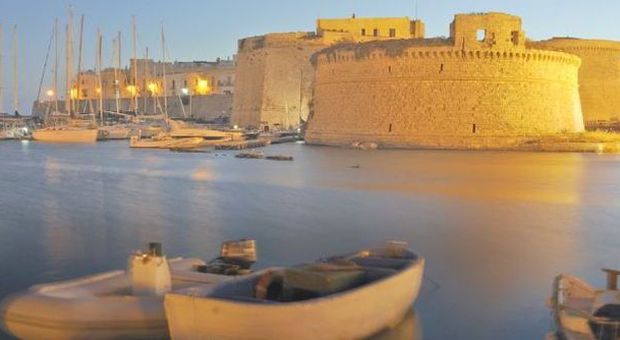Furthermore, two additional initiatives will be inaugurated this year, “Puglia Open Days Kids” and “Puglia Open Days for All,” bringing art and culture to children and those with specific disabilities. These projects underscore and anticipate quite beautifully the Lecce2019 committee’s project in the candidacy for European Capital of Culture. POLIStopia, branch of DEMOCRAtopia, this utopian ideal aims to create a city which is open to all, and transforms people with special needs into people with special abilities. The inclusion of everyone, as each individual is an important resource for every community, in this grand project of art and culture is definitely a model for the future.
But if art and culture are the queen’s crown, then its most precious jewels are its elegant cathedrals and imposing castles which sparkle brilliantly from the northeastern Gargano all the way to finibus terrae in Santa Maria di Leuca. And most certainly the king of all castles is Castel del Monte, A UNESCO Human Heritage site, built by Frederick II in 1240.
Well worth a trip up the 550-meter slope, what is exceptional about the opening is the view one must see of the nightsky across the Murgia plain.
From the Itria Valley near Brindisi is the Ducal Castle in Ceglie Messapica. The symbol of the town, a 1000-year old, 35-meter tower looks out onto the lower Adriatic sea and the Otranto Canal. Eastward, Ostuni’s Cathedral of Santa Maria Assunta is a rare and Gothic princess with her original facade and well worth a detour. Travelling west to old Magna Grecia, spend an evening in Taranto to visit its Aragon Castle, or Castel Sant’Angelo, a particularly magnificent landmark of the Ionian sea. Its low and wide towers bear witness to a feuding past, and the castle was used as a prison during the Habsburg rule, while today it is home to the Italian Navy headquarters. This extraordinary opening in the heart of Ancient Greece should not be overlooked.
But beyond the regal fortress, Taranto’s origins and history are of incomparable archaeological importance. Originally a Spartan colony, Taras was once Italy’s largest commercial port town of Ancient Greece. The findings brought to light over the centuries attest to its impressive history, and the collections which bear witness to this ancient past are in one of Italy’s most important museums, the MARTA, The National Museum of Archaeology. Home to artifacts from Ancient Greece, the Roman period, and late antiquity, visit the rooms which house the golden objects of the funerary tombs of the necropolis dating back to the 4th and 3rd Century, and you will see literal jewels of Spartan princes along your journey to discover Puglia’s architectural royalty.
Heading south along the Ionian coast an extraordinary event can not be overlooked: the re-opening of the even more extraordinary Castle of Gallipoli. Closed to the public for over 150 years, tomorrow’s re-opening marks an end to an entire era. Dominating the entrance of the old town of Gallipoli or Kallipoli, the beautiful city, the Angevine-Aragonese castle with its 5 towers is completely surrounded by sea and within its fortified walls lies the town’s significant history. Throughout the various epochs it was used as a refuge for many royal figures. The re-opening is thanks to the association Sistema Museo of Perugia which will manage alternating exhibits with guided tours from 10 am til midnight every day. The inaugural show, “Scatti di cinema, la Puglia al cinema” was created by the Apulia Film Commission. Visit the castle while taking in further beauties of Puglia through the stills from a picture show.
Travel back north halfway to Lecce and take a detour into Nardò with its regal Romanic-Baroque basilica, the Cathedral of Santa Maria Assunta, and a national landmark. And afterward just a few miles outside Lecce, reigns a rare prince, the Castle of Copertino. It is the only historical site in Puglia’s Open Days program that is part of the Cultural Heritage Ministry of Italy. The fortress represents one of the most impressive and largest defensive structures in Salento, but it is also characterised by lovely decorations on the door by Gianserio Strafella, the Mannerist painter from Copertino.
Originally built during the Norman period to defend the region, it was rebuilt on a previous Angionian fortress and completed in 1540 by Emperor Charles V's architect Evangelista Menga. Finally in Lecce itself, dominating laterally the Baroque city center and its numerous churches, is the Castle of Charles V, and reminds us once again of the Spanish empire which dominated the peninsula in the 16th Century. Lastly on our jewel-clad journey, we end at the eastern-most point of Italy, the port town of Otranto, whose tumultous past has left a tiara of gems just meters from one another, the Aragonese Castle, the Cathedral of Santa Maria Annunziata, and the Byzantine church of San Pietro, all visitable Saturday nights for free. “Puglia Open Days” certainly does great honor to the throne of art and culture and is truly a gift worthy of kings and queens.

